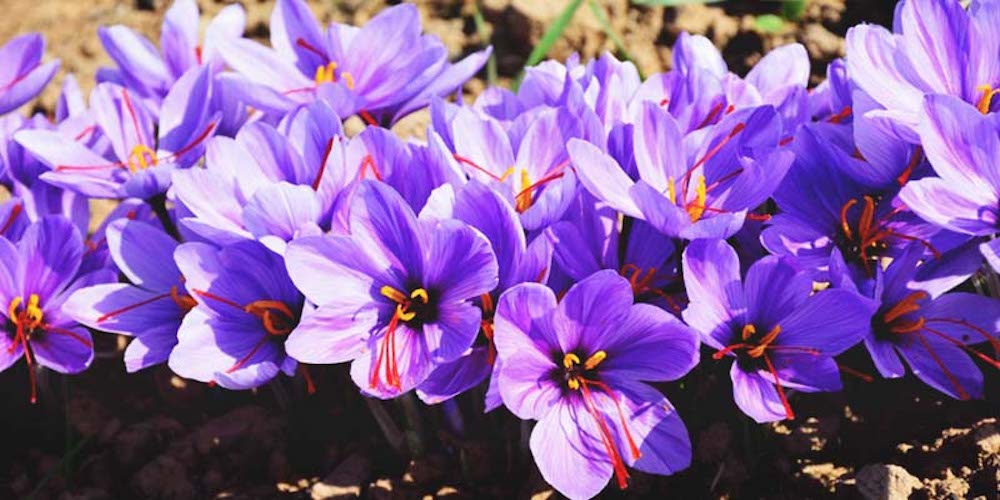Saffron bowl of India now extends from Kashmir to Sikkim and the North-East

North East Centre For Technology Application and Reach (NECTAR), an autonomous body under the Department of Science & Technology, Government of India, has proudly achieved something that was considered hitherto unthinkable.
Through the Botany and Horticulture department of Sikkim Central University, the NECTAR has successfully completed a pilot project of transplanting Saffron plants from Kashmir to Sikkim.
As a result, the saffron bowl, which was so far confined to Kashmir, may soon expand to the North East of India
Plants from seeds transported from Kashmir to Sikkim and acclimatized there are now flowering in Yangyang village in the Southern part of the North-Eastern state, with the same quality in size and colour but in higher quantity.
Saffron production has long been restricted to a limited geographical area in the Union territory of Jammu & Kashmir. Pampore region, commonly known as Saffron bowl of Kashmir, it is the main contributor to saffron production, followed by Budgam, Srinagar, and Kishtiwar districts. Saffron has traditionally been associated with the famous Kashmiri cuisine. Its medicinal values are considered as part of the rich cultural heritage of Kashmir.
As saffron growing was confined to very specific areas in Kashmir, its production remained limited. Though the National Mission on Saffron focused on several measures to improve its farming, the measures were still limited to the specified areas of Kashmir.
It is against this background that the Botany and Horticulture department of Sikkim Central University carried out tests to understand the soil and actual pH conditions of Yangyang of Sikkim and found it comparable to saffron growing places of Kashmir. Saffron seed/corms were purchased and air transported from Kashmir to Yangyang village – site by the department. One saffron grower from Kashmir was engaged and stationed to look after the complete growing process, along with the faculty of the university.
The corms were irrigated during the month of September and October, which ensured timely corm sprouting and good flower yields. The matching of climatic and geographical conditions between Pampore (Kashmir) and Yangyang led to the successful sample farming of Saffron in Yangyang.

The first crop of saffron was produced in September and has been grown across 1,000 square metres. According to Dr Arun K Sarma, Director General, North East Centre for Technology Application and Reach (NECTAR), the current production is expected to be scaled up to ten times in Sikkim once they assess the quality of the saffron.
The project also focused on post-harvest management and value addition of saffron so that quality saffron drying and efficient post-harvest processing can improve saffron recovery, thereby improving its production.
Further, detailed analysis and testing of all parameters, including soil testing, quality, quantity, and possible value addition are planned, for immediate results and extrapolation of the project to other parts of the North East Region along with Micro Food Enterprises.
As has been noted already, so far saffron- cultivation has been restricted to limited areas in Jammu & Kashmir – Pampore, Srinagar, Budgam, and Kishtwar. Notably in India, 6 to 7 tonne of saffron is produced annually. However, the demand in India is 100 tonne and in order to meet that, the country has to import saffron.
Incidentally, one kilo of saffron that is indigenously produced grown costs between Rs 1.5 lakh and Rs 2 lakh.
Saffron needs to remain underground for about 45 days at sub-zero temperatures. It also requires adequate rain, especially once sown in August.
“The pH level of the soil was a particularly important factor. Our Kashmiri saffron farmer involved in the project has found that the flower seems to be exactly the same as that grown in Kashmir, with similar properties such as the thickness etc. Nevertheless, we are carrying out a scientific analysis of the plant to see how it compares to the saffron plant in Kashmir”, says NECTAR Director Sharma, adding, “ We are also looking at extending the cultivation of saffron to Meghalaya and Arunachal Pradesh, where we feel that the conditions are favourable.”
This development gains extra significance as it is the first successful cultivation of Saffron in Sikkim and possibly in Northeast India. It indicates the immense possibilities for indigenous farmers as saffron is a cash crop and its demand is very high all over India.


